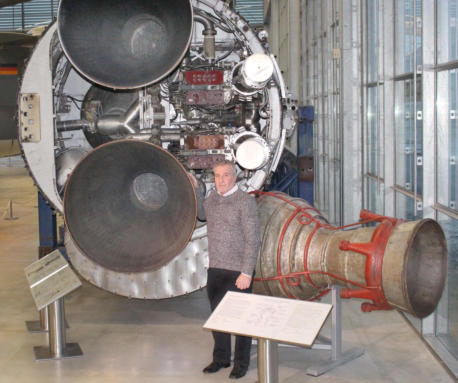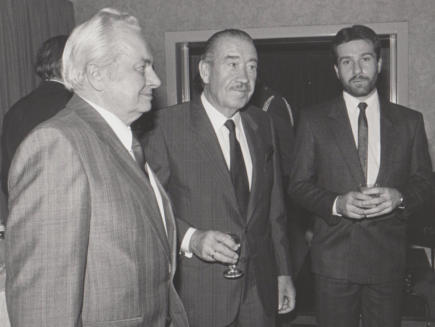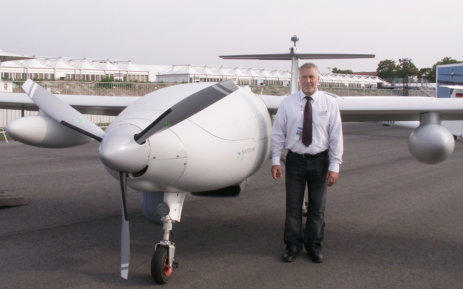
Uwe W. Jack
Many years of my work as an author were recognized by the Hugo
Junkers Award for the best (German-language) aerospace publication
in 2019. But starting this career was rather difficult.
I was born in 1956 in the American sector of Berlin divided into a
western and a Russian part. As long as I can remember, I am
fascinated by aircraft and rockets. My grandfather sparked this
passion when he gave me a model of a Messerschmitt Me 262 and a
Redstone rocket for my seventh birthday.
Starting with a disaster
At school, I never was an ambitious boy. When I was ten, bad pupils
got the chance to improve their grades with a short presentation.
I choose rocketry as my theme. The centerpiece for my presentation
was a two feet long paper model of a rocket that I build at home. On
one side the tabular fuselage was white with black squares, had a
pointed nose and triangular fins at the end. Turned around, the
fuselage was cut open to show the interior: A crew compartment at the
top, two fuel tanks, and a rocket engine at the bottom.
When I came to the fuel-tanks, my teacher stopped me. There must
be something wrong - her car and all other cars in the world had only a
single fuel tank. Why should any vehicle need two different fuels? As a
ten-year-old boy, I was unable to convince such an ignorant teacher.
So rocketry could not improve my grades.
Listening to veterans
Beginning as a high school student, I took every opportunity to listen to
aviation veterans, mostly Luftwaffe crew-members. In the early 1970s,
some Apollo astronauts visited Berlin and through good contacts, I had
the chance to speak to men who walked on the surface of the moon.
So I decided to become a rocket engineer - and to build my own
liquid-fueled rocket engine. The device was very small and was
assembled on my kitchen table. Air-pressure for fuel injection was
provided by a car tire. The engine produced only a maximum thrust of
under one pound - but worked.
After I started studying aerospace engineering, I ask the librarian for
books describing the design of small rocket engines. The chairman of
the institute, Heinz-Hermann Koelle, heard this and commanded me
into his office. He was a legend: the former deputy to Wernher von
Braun at Huntsville, he was in the team that launched Explorer 1 in
1958 and was responsible for the design of the Saturn I. After he saw
some pictures of my engine the next day, he seems to be impressed.
We had a long talk about rocket history and I was invited several times
when former Peenemünde engineers visited Berlin. They offered me a
job in the US space industry, but my wife does not want to leave
Berlin, so I stayed and dropped out of studies. Since it was forbidden
for Germans to work in Berlin in the aerospace business - I had to look
for other professions.
In the printing and aviation industries
Printing was my second passion, I learned to operate a printing press
at the age of 14. Working with a company that was implementing
computers in the graphics process in the early 1980s was a real
challenge. We had a very creative and dynamic team - a fine time!
When the Berlin wall came down, this company sadly collapsed in
1990.
Fascinated by the new digital printing technology, I worked there
until a small aviation company near Berlin was looking for someone to
write aircraft documents and manuals and to help marketing an
uncrewed autonomous reconnaissance aircraft. For some years I
crawled deep into the interiors of aircraft and into the art of collecting
data from a flying sensor-platform.
When a German aviation magazine offered me to join its editorial
staff where I should be responsible for aerospace history and
spaceflight, I didn't hesitate for a second. That’s where I was for
interesting years. Then I retired to have time for my own projects. But
after a few months, the FliegerRevue called me back to work…
Searching for new information between dusty papers
In 1975 I started my private investigation on aerospace secrets. In the
archive of the Deutsches Museum in Munich, I met the british historian
David Irving, who at this time was respected for his books on German
secret weapons and the Luftwaffe. Although we're at the opposite ends
of the political spectrum today, he taught me a lot about research. A
picture or document is not the reality, he told me, it is only one of many
layers of a complex history and just reflects the insight that the creator
had. Since then I am always critical when looking at pictures or
reading documents.
Having searched tons of documents, I discovered some mysterious
facts that stand in contrast to the published aerospace history,
especially on Luftwaffe aircraft. Over years I helped other authors but
decided that it is now time to see my name printed on the cover.
Meet the author






Receiving a publishing award from Bernd Junkers (left), the grandson of the
famous aviation-entrepreneur Hugo Junkers.
With a Messerschmitt Me 262 - my favorite aircraft,
because my grandfather built this type in 1944/45.
Meeting Adolf Galland (middle), the commanding General of the
Luftwaffe fighter force of WW2. To the left stands Feldwebel Zech,
one of the first to fly the “longnose” Fw 190 to protect the Luftwaffe
jet units. A much younger Uwe is to the right in 1986.
With two remarkable pieces of rocketry. The unfortunate Europa rocket
and an engine of the V-2.
Searching for documents of the early rocket
pioneers in an archive.

Even though I don't own a pilot's license, I can't resist climbing
into every cockpit. This time it is a Junkers Ju 52 Trimotor.
In Fort Worth, Texas at Lockheed Martin, I had the chance to
“fly” the fascinating stealth fighter F-35.

Questions and Answers
Why are there documents for free download and why do you
publish your work??
For decades I have searched archives for rare documents and
interviewed aviation witnesses. As a young man, I didn't have any
original photos or documents. The author Heinz J. Nowarra helped
me at the time and left me a lot of photos. That gave me the courage
to continue studying the history of aviation.
With the free distribution of many of my documents, I would like
now to help other historians and motivate young people to also
devote themselves to the many exciting puzzles of aerospace
history. This is my mission.
I see myself as a part of the community of historians and would
like to share my findings and - of course - the joy of research with
others.
Yes! “Jack” is my family name.
It is most likely that my ancestors came from the United Kingdom.
Jack is the acronym for the Apostle St. Jacob. Three hundred years
ago, the German state of Prussia gave immigrants from the UK a
piece of land, a house, and a cow to settle down. My family did this
at the German-Russian border.
The “W.” stands for Willi
This is to honor my grandfather Willi Jack (1909 - 1995). He was a
locksmith working for the aircraft company Henschel south of Berlin
and was loaned to Messerschmitt in autumn 1944 to produce the jet
Me 262. As a Socialdemocrat and pacifist he does not want to carry
a rifle for the nazis (therefore he was working in the aviation
industry).
He shared his meals with the Russian POW’s working at
Messerschmitt. For this, he was sentenced to prison with water and
bread - postponed to after the “final victory”.
Which of the astronauts did you like most?
With Alan Bean (Apollo 12) I had a long conversation of about one
hour. He had a good sense of humor and was very charming. I loved
his straightforwardness. When I asked questions about his
experiences in aircraft, he always ground his teeth when I called him
“pilot”. Too late I remembered that as a Navy man, I must have
called him “aviator” - sorry Alan!
Unfortunately, I never met Alan Shepard. He is my favorite
Astronaut. I was very impressed by his attitude of never giving up.
After an inner-ear disease grounded him, he struggled back into a
spacecraft seat and landed with Apollo 14 on the moon. When his
landing radar failed, he took over manually and made the most
accurate landing of all moon missions.
So: “Never give up!”
What is your favorite aircraft and rocket?
The Messerschmitt Me 262 is my star not only for family reasons. It
changed aviation technology. The X-15 rocket plane comes
immediately afterwards. It pushed the limits of aviation into space.
For me, the Atlas rocket is the symbol of uncompromising design.
I admire the work of the engineers in making such a low structural
weight fly reliably.
What do you do when you are not writing?
When I am not searching for aerospace secrets or writing, I read
science fiction books and I love to listen to my wife when she talks
about dolphins, or to follow her on her hunt for new handbags.
What annoys you the most?
I get annoyed by the people who after a one-hour lecture or an 20-
page-article, comment: “ You gave the maximum speed with Mach
1.8 - I have a book that describes it more precisely as Mach 1.79.”
More and more people do not see the whole picture, but only tiny
errors attract their attention. I see this as a dangerous development -
don't let these people stop you!

Text: English plus German

Promoting the unmanned hightech UAV Stemme/Safran
“Patroller” aircraft at an air show.








